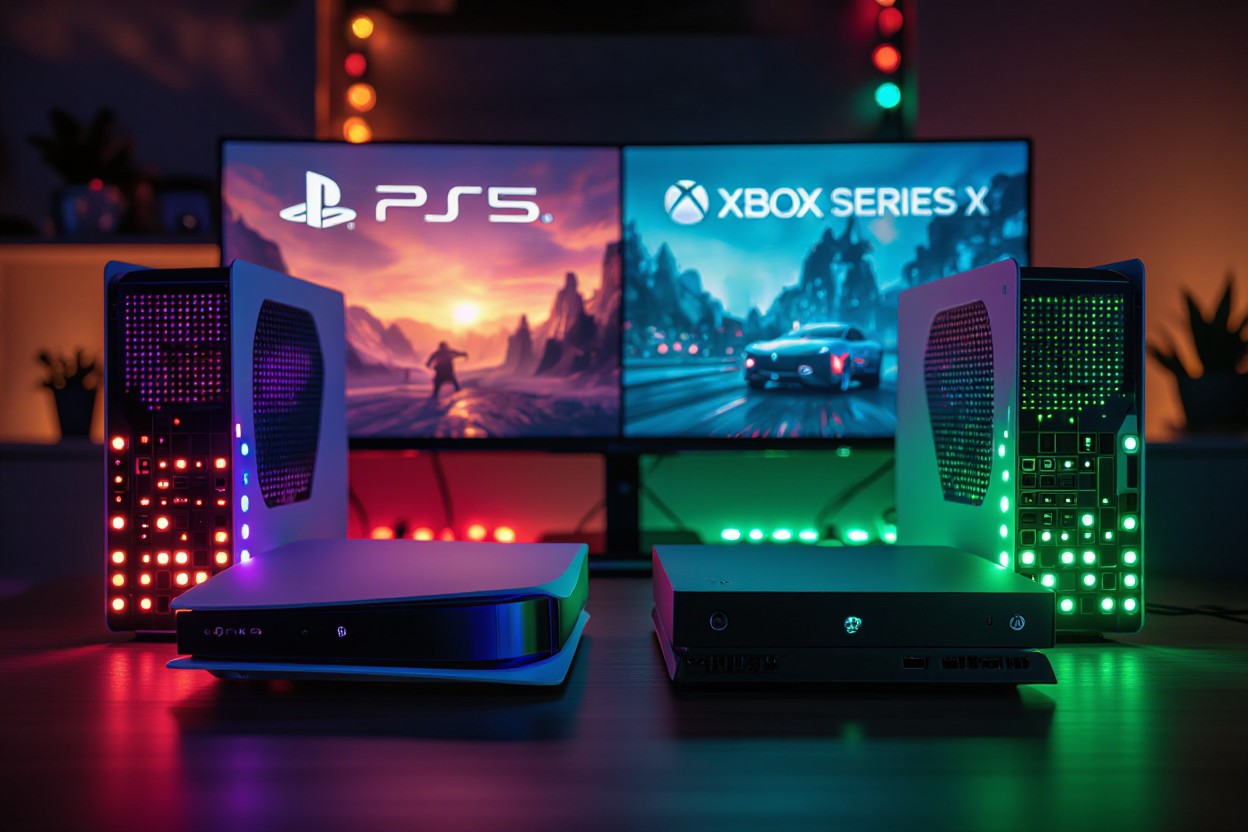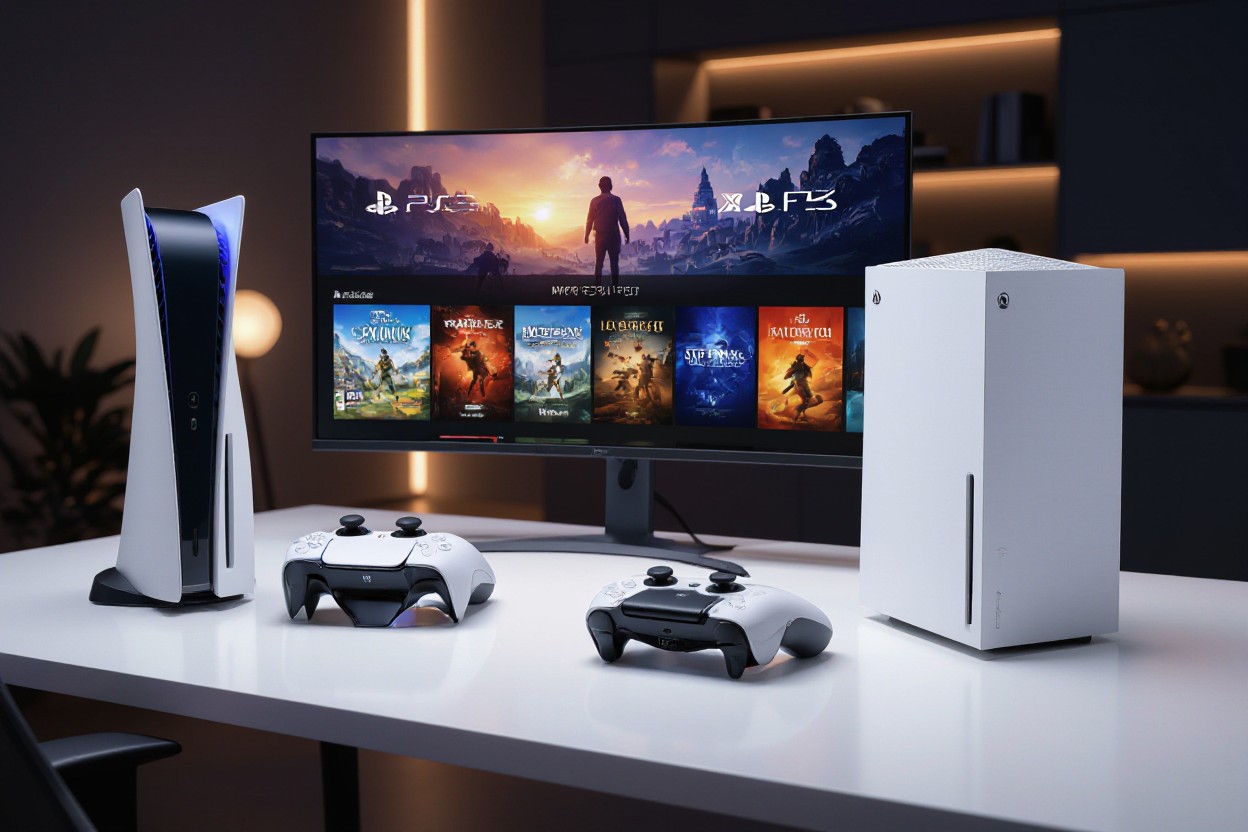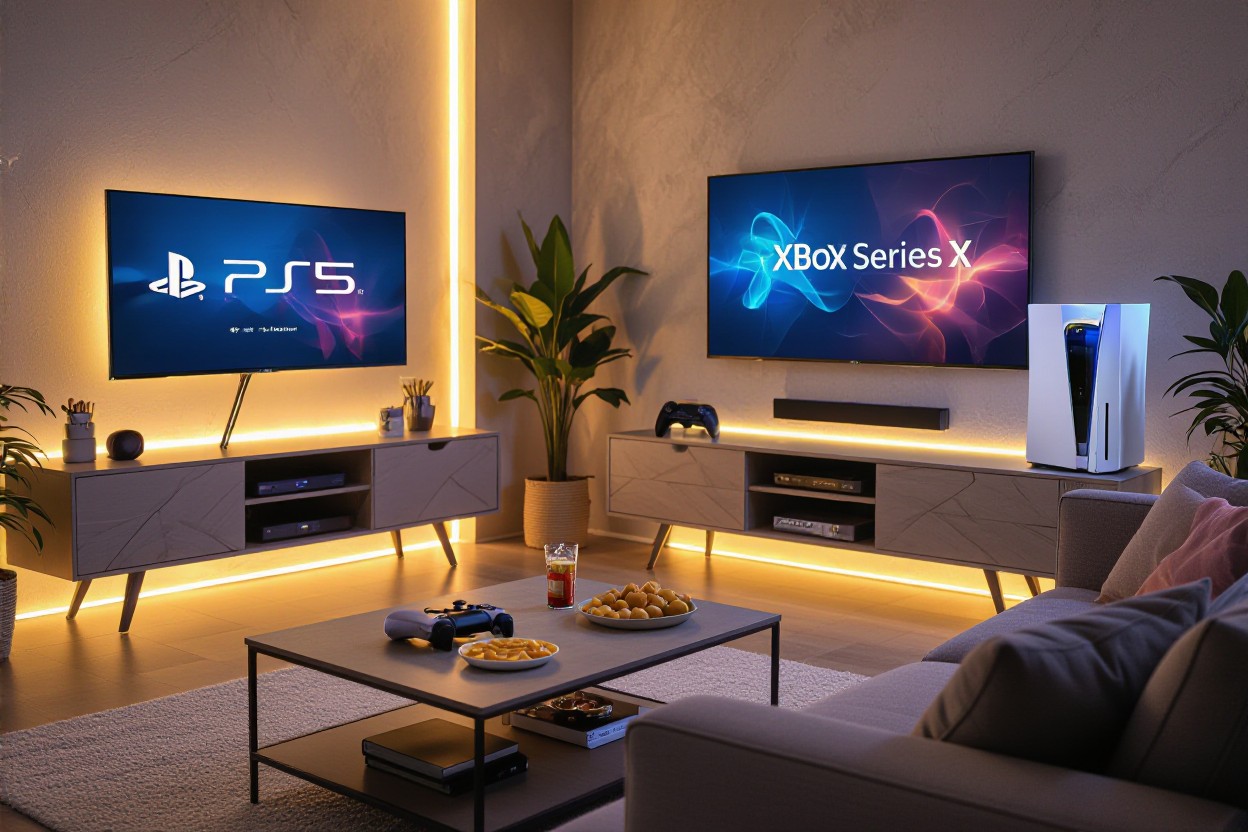Over the past few years, I’ve explored the strengths and weaknesses of both the PS5 and Xbox Series X to help you make an informed choice. These powerful next-gen consoles offer impressive graphics, lightning-fast load times, and exclusive games that can define your gaming experience. However, understanding their key differences—like controller design, game libraries, and performance—can significantly impact which one suits your needs best. In this guide, I’ll break down the most important features and potential pitfalls so you can decide which console truly wins for your gaming lifestyle.

The Power Struggle: Hardware Specifications Decoded
Both the PS5 and Xbox Series X pack impressive specs under the hood, but the nuances reveal where each console excels. The Xbox Series X boasts slightly higher GPU power, pushing 12 teraflops compared to the PS5’s 10.28 teraflops, which translates into potential raw graphics performance advantages. Meanwhile, both systems use AMD Zen 2 CPUs, but subtle clock speed differences affect multi-threaded tasks. I’ve found these specs shape the overall user experience, from frame rates to rendering detail, making it a true battle of engineering to see which console edges out in real-world gameplay.
CPU and GPU Performance
Examining CPU performance, the Xbox Series X operates at a higher clock speed (3.8 GHz) compared to the PS5’s variable frequency up to 3.5 GHz, giving it a slight edge in processing power. The GPU side features the Xbox’s 52 compute units versus PS5’s 36, contributing to Xbox’s superior raw graphical throughput. However, PS5’s innovative GPU architecture and efficient ray tracing implementation often narrow the gap in visual fidelity and frame stability. In practical terms, this means Xbox may push higher resolutions or frame rates, but PS5 can deliver unique performance optimizations during demanding scenes.
Storage Solutions and Load Times
The PS5’s custom NVMe SSD operates at a blistering raw speed of 5.5 GB/s, significantly reducing load times and enabling innovative game design with near-instant asset streaming. In contrast, the Xbox Series X features a slightly slower 2.4 GB/s NVMe SSD, yet takes advantage of a robust Velocity Architecture that optimizes throughput and manages decompression efficiently. Both consoles load games impressively fast for their generation, though PS5’s storage excels at virtually eliminating wait times during transitions, which can enhance immersion substantially.
Diving deeper into storage, PS5’s ultra-fast SSD allows developers to create expansive worlds with seamless asset swaps, which is particularly evident in titles like Demon’s Souls and Ratchet & Clank: Rift Apart. This speed doesn’t just impact load time; it transforms level design possibilities by removing traditional bottlenecks. Xbox Series X compensates with a flexible expansion system and a smart storage controller, ensuring game assets load quickly and consistently, alongside extensive backward compatibility support. I find the PS5’s edge in native SSD speed offers a transformative experience but Xbox balances with a more versatile and expandable ecosystem.

Exclusive Game Lineups: Who Has the Edge?
Both the PS5 and Xbox Series X offer impressive exclusive games, each appealing to different tastes. Sony continues leveraging powerhouse studios like Naughty Dog and Insomniac Games, while Microsoft invests heavily in acquiring top-tier developers such as Bethesda. Your choice may hinge on whether narrative-driven adventures or expansive RPGs take priority, as the PS5 leans towards cinematic single-player experiences, whereas Xbox focuses on broad, immersive worlds and backward compatibility for older hits.
Blockbuster Titles and Franchise Lifecycles
PS5 shines with blockbuster franchises like Spider-Man: Miles Morales and Demon’s Souls, delivering high-fidelity, story-rich exclusives. Xbox Series X counters with its revitalized franchises such as Halo Infinite and Forza Horizon 5, receiving continual updates and expansions that keep players engaged over extended periods. Microsoft’s model supports longer franchise lifecycles with cross-platform play and Game Pass integration, enticing sustained player investment.
Indie Game Support and Accessibility
Indie titles on both platforms see increasing support, but Xbox’s Game Pass injects exceptional accessibility, granting you a vast indie library at your fingertips. Sony’s curated indie showcases still offer quality, but Xbox’s focus on volume and variety often presents a more diverse range of innovative experiences to discover.
Diving deeper into indie game accessibility, Xbox Series X’s Game Pass emerges as a game changer. It features over 100 indie games, allowing you to explore titles like Hades and Celeste without additional purchases, lowering barriers for experimenting with smaller, creative studios. Meanwhile, Sony’s PlayStation Store occasionally highlights promising indies through seasonal sales and showcases, yet doesn’t bundle them in a subscription service of similar scale. For gamers who thrive on fresh, unique gameplay experiences, Xbox’s approach often delivers more bang for your buck and encourages greater discovery within the indie scene.
User Experience: Interface and Online Services
Both the PS5 and Xbox Series X aim to streamline navigation and improve your online engagement, yet they adopt notably different approaches. Sony’s interface focuses on a clean, immersive experience with quick card-based access to recent activities. In contrast, Xbox prioritizes customization and integration with its broad ecosystem, including Windows. Beyond UI, the quality and value of online multiplayer services define much of the long-term enjoyment and community-building on each platform.
UI Design and Usability
The PS5’s UI introduces the Control Center, which slides in instantly via the DualSense, providing immediate access to game stats, friend lists, and notifications without leaving gameplay. This design sharpens focus on flow and immersion. Meanwhile, Xbox maintains a more traditional, tile-based interface familiar to veteran users, with extensive options for personalizing layout and pinning apps. Overall, PS5 favors minimalism and speed, whereas Xbox offers broader depth and adaptability in its user interface.
Online Multiplayer and Subscription Models
Xbox Series X’s Xbox Game Pass Ultimate combines Xbox Live Gold’s multiplayer capabilities with a vast library of over 100 games, including first-party releases on day one, offering exceptional value. PS5’s PlayStation Plus has evolved into a tiered system—Essential, Extra, and Premium—balancing multiplayer access, classic titles, and cloud streaming. While Xbox leads in subscription breadth, Sony invests heavily in exclusive multiplayer experiences like *Returnal* and *Ratchet & Clank: Rift Apart*, which leverage PS Plus’s ecosystem to foster player engagement.
Diving deeper, Xbox’s Game Pass Ultimate not only covers online multiplayer but also integrates EA Play, making it a comprehensive entertainment package, particularly appealing if you value a steady stream of new titles and cross-platform play. Subscribers experience seamless matchmaking, party chat, and cross-generational multiplayer features. Sony’s tiered PS Plus model, meanwhile, enhances value gradually, rewarding long-term subscribers who prioritize access to expansive classic game catalogs and cloud-based play. Your choice depends on whether you prefer a consolidated gaming hub or more curated multiplayer-focused perks.

The Living Room Experience: Design and Functionality
Both the PS5 and Xbox Series X bring distinct approaches to living room integration, balancing form and function. The PS5’s towering white chassis commands attention, often becoming a centerpiece, while the Xbox’s minimalist, monolithic black box blends more subtly into entertainment setups. Storage options, ventilation design, and user interface intuitiveness also shape how each console feels in daily use, influencing not just gameplay but overall comfort and accessibility. I find that how these consoles interact with your living room environment can be a decisive factor, sometimes even outweighing raw performance or exclusive game preference.
Aesthetic Appeal and Space Optimization
The PS5’s bold, futuristic design features curved panels with LED lighting, making it a statement piece but demanding ample vertical space—standing at nearly 16 inches tall. Conversely, the Xbox Series X measures a more compact 6.5 inches wide and 11.8 inches tall, designed for easy horizontal placement in tighter entertainment centers. If your living room is smaller or you prioritize blending hardware seamlessly, the Xbox’s smaller footprint offers better space optimization without sacrificing ventilation efficiency, an aspect that can affect long-term hardware longevity.
Ecosystem Integration: Compatibility with Other Devices
Your console’s ability to synchronize with other devices adds significant value beyond gaming itself. The Xbox Series X excels here with deep integration into Microsoft’s ecosystem, allowing seamless functionality with Windows PCs, Xbox Game Pass on PC, and streaming via Xbox Cloud Gaming on mobile devices. The PS5 also supports Remote Play and offers some cross-functionality with the PlayStation App, but Xbox’s partnerships with Windows enhance productivity and entertainment convergence, making your console part of a wider digital lifestyle hub.
Delving deeper, Xbox’s ecosystem integration benefits especially those who use multiple Microsoft services. For example, Xbox’s Quick Resume supports toggling across games that synchronize automatically with Xbox Cloud saves, enabling transitions between console, PC, and mobile without data loss or manual setup. Xbox controllers also connect effortlessly with Windows PCs via Bluetooth, consolidating your gaming hardware. Meanwhile, the PS5 integrates tightly with PlayStation VR and the PS Vita, but outside the Sony universe, cross-device compatibility is more limited. If you prioritize a multi-platform media setup, Xbox’s architecture provides more robust and flexible options for blending gaming with other entertainment or work-related activities.
Price and Value Proposition: Are You Paying for Quality?
Evaluating price against performance between the PS5 and Xbox Series X reveals nuanced trade-offs. The Xbox Series X launched at $499, offering raw power and a compatible game library bolstered by Xbox Game Pass. The PS5 also debuted at the same price point, focusing on exclusive titles and its ultra-fast SSD technology. Although both consoles mirror each other initially, your choice hinges on whether you value immediate game accessibility, hardware strength, or exclusive game ecosystems, which together define the overall value beyond just the sticker price.
Initial Costs vs. Long-Term Investments
Choosing between initial outlays and long-term value, consider that both consoles’ hardware investments are similar, but ongoing costs diverge. Subscriptions like Xbox Game Pass can minimize game purchases over time, potentially saving you money if you play frequently. On the other hand, PS5 players may invest more in individual AAA titles. Accessory costs and replacement parts also factor in; meanwhile, the durability and ecosystem compatibility can influence how long your console stays optimal, affecting total cost of ownership.
Best Bundles and Promotions
Occasionally, retailer bundles make each system more attractive. Xbox Series X bundles often include Xbox Game Pass Ultimate or popular titles like Halo Infinite, offering added value that enhances ongoing play without extra expense. PS5 bundles tend to focus on exclusive game combinations or accessory packages, providing a comprehensive starter kit for new players. Tracking seasonal sales on both consoles uncovers deals bringing peripherals or digital content at a discount, improving your initial setup options significantly.
Digging deeper into bundles, Xbox frequently partners with large retailers to provide limited-edition consoles or exclusive skins bundled with subscription perks like Xbox Game Pass for 12 months, which can drastically reduce costs for avid gamers wanting access to an extensive library. Sony, meanwhile, excels in tying game launches with console sales, offering early adopters PS5 versions of titles like Ratchet & Clank: Rift Apart bundled regularly, giving you a head start. Comparing these offerings over time can help you determine which console’s bundle strategy maximizes your investment based on your gaming preferences and budget flexibility.
Summing up
Presently, when deciding between the PS5 and Xbox Series X, I find your choice hinges on what you value most in gaming. The PS5 impresses with its innovative DualSense controller and exclusive titles, creating a unique experience. Meanwhile, the Xbox Series X offers raw power and a superior backward compatibility library, appealing to those wanting performance and variety. I encourage you to assess your preferences for games, ecosystem, and services to determine which console aligns best with your gaming ambitions.




Leave a comment